The Hvítá River
By Michael Chapman
Salmon Fishing, White-Water Rafting and Waterfalls await!
The Hvítá River
By Michael Chapman
Salmon Fishing, White-Water Rafting and Waterfalls await!
The Hvítá river in South Iceland is a force of nature parallel to none. Read on to learn more about this stunning natural waterway.
Water is an omnipresent force in Iceland, revealing itself in its wind-battered shorelines, snaking rivers and glaciers, and its tendency to douse unwary citizens with rain and snow. To put it another way, if Iceland were an amusement ride, then it would almost certainly be one with a sign out-front stating ‘Be warned—you will get wet.’
Even summer visitors cannot avoid a sound drenching from time to time; Iceland’s weather is temperamental, akin to a teenager’s moods, and is more than capable of switching at a moment’s notice. Guests in the winter might be better prepared, sound in the knowledge that soaked clothing and frozen drops around the mouth are all part of an authentic Iceland experience.
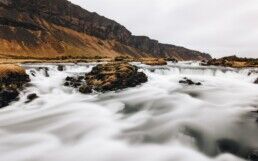
One of the best ways of celebrating Iceland’s water-cycle is by appreciating its glacial rivers, of which there is already a well-established favourite here. Trailing worm-like from the mighty Langjökull glacier, the Hvítá river has long been held in high esteem by local Icelanders for its beauty, purity and crucial role in irrigating the land.
At the same time, the river is feared on account that it floods during heavy rainfall. The main reason for this is the Hvítá river often swallows smaller rivers in the region; thus changes to its flow have a more significant influence over the farmlands and villages of South Iceland. In some particularly bad years, a few settlements have been cut off from major transit routes due to excessive water.
Useful Information about the Hvítá river
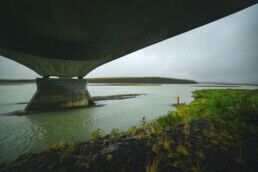
The Hvítá river can trace its origins to Lake Hvítárvatn, roughly 45 kilometres north of the waterfall, Gullfoss. Both the lake and river share the common ‘Hvít’ (White) as part of their name due to their water colour, which in some light, appears close to snow-white. Hvítárvatn covers a total area of 30 km² and boasts a maximum depth of 84 metres.
From the lake, the river travels 40 kilometres (25 miles) south, finally arriving at Gullfoss waterfall, after which it joins with other smaller rivers including the Tungufljót and the Brúará. Now doubled in volume and power, maps show how the Hvítá joins the Sogið river, soon transforming into the Ölfusá river not far from the small town of Skalholt. If added to the Ölfusá’s full-run, then the Hvítá is considered part of the third-longest river in the country.
There are several small, picturesque villages on the Hvítá river besides Skaholt. Guests could stop by Flúðir, famed for its columns of floating steam and the Secret Lagoon spa, or Sólheimar Ecovillage, where just over 100 residents live in perfect symbiosis with nature.
PLAN YOUR JOURNEY
Travelling to Iceland?
Check our overnight tours with a driver guide that includes a one night stay in a bubble.*Starting from ISK 74.900 per person
Salmon Fishing on the Hvítá river
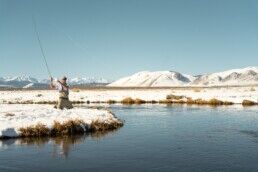
Fishing is a brilliant way to connect with Iceland’s natural environment, providing all those who cast the line with a sense of tranquillity and focus. Thankfully, the Hvítá river is known for being one of the best salmon fishing rivers in the country, offering large stock for anglers and fishermen looking for that prize catch.
Salmon are not found throughout the river but tend to congregate at certain spots, namely where other rivers and tributaries join the greater body of Hvítá. Brown Trout and Arctic Char are also known to frequent the river, providing some diversity to your encounters.
Please be aware that fishing in Iceland without the landowner’s permission is strictly prohibited, and fines await anyone who might attempt to break the rules. Even the landowners themselves are subject to legislation that is far too tedious to go into here. For this reason, we advise taking a fishing trip with a professional tour operator as not only will they know the best spots, but will already have dealt with the legal aspects of the experience.
White Water Rafting on the Hvítá river
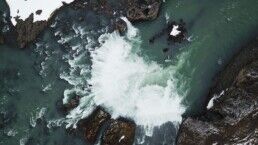
White water rafting is, without question, one of the most thrilling activities that guests can participate in on the Hvítá river. Don’t worry if you’ve never tried your hand at such a thing before; rafting guides in Iceland are experienced, knowledgeable, safety-conscious and, above all, well practised in introducing beginners to the ways of the river.
As you navigate your way through the thrashing waters, you will pass through sites of epic beauty, including the towering walls of Brúarhlöð Canyon. At this site, in particular, it is impossible not to gain some understanding of just how powerful, how influential, the Hvítá has been sculpting the landscape throughout the centuries.
If white-water rafting isn’t your bag, there are other options suited to the solo adventurer. Taking a kayak or a canoe is the best means of setting yourself a fun personal challenge on the Hvita, bypassing the cooperation and numbers necessary for a white-water rafting tour. Just make sure to follow your guide’s instructions throughout, and don’t tackle any rapids that you don’t feel comfortable with.
Gullfoss waterfall
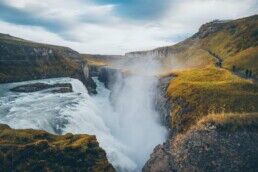
Without argument, Gullfoss waterfall is the river’s most popular addition, drawing crowds in their thousands every year. From two viewpoints, visitors can watch as frothing white water topples a total of 32 metres over two cragged ‘steps’. Such is the Gullfoss’s power that a constant plume of mist is present over the site, and can often be seen en route before the waterfall itself.
Of course, Gullfoss is one of the three main attractions that make up the famous Golden Circle sightseeing route in South Iceland, the other two being Þingvellir National Park and Geysir geothermal springs.
Available to visit in both the summer and winter, we recommend you book our esteemed Golden Circle bubble tour. Aside from having us lead you around the area’s most prestigious sites, you will spend the night looking out for the Northern Lights from your very own transparent bubble accommodation.
What other rivers are in Iceland?
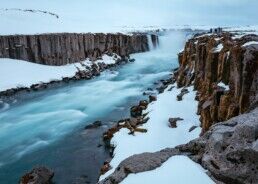
Rivers are plentiful in Iceland, with all the island’s glaciers spouting numerous tributaries from which its water escapes to the Atlantic. While overseas guests might more often visit the Hvítá if only for its proximity to Reykjavik, there are countless other glacial veins that stretch out over this delicate landscape.
Jökulsá á Fjöllum (‘The Glacial Mountain River’) originates from the great glacier Vatnajokull, and is best known for the enormous drop that interrupts its passage; Dettifoss. Often cited as having the most powerful flow rate of any waterfall in Europe, Dettifoss is a dramatic and awe-inspiring powerhouse surrounded by swathes of alien-grey rock formations.
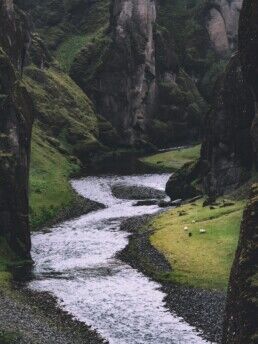
Another important river is the 155 kilometre-long Kúðafljót, which creates staggering colour contrasts as it rushes across the black sand desert of Solheimasandur. To the northwest, the river Blanda travels from Hofsjökull glacier to Húnaflói bay, making picturesque scenery for anyone stopping by the small village of Blönduós.
Other rivers that guests can discover around Iceland include the Fnjóská (‘The River of Dry Wood’), the Jökulsá á Dal (‘Glacial River of the Vale’) and the Skjálfandafljót (‘The River of Tremble’), to name just a handful. If you wish to learn more about Iceland’s rivers, take a glance at the government’s National Parks and Other Protected Areas page.
Make sure to keep an eye on the passing scenery as you travel from region to region; you never know what you’ll discover around the next bend of the river.
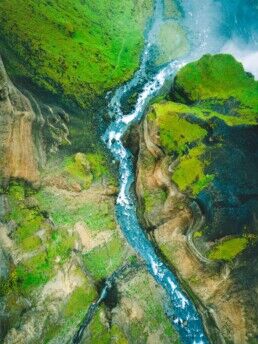
PLAN YOUR JOURNEY
Travelling to Iceland?
Check our overnight tours with a driver guide that includes a one night stay in a bubble.*Starting from ISK 74.900 per person